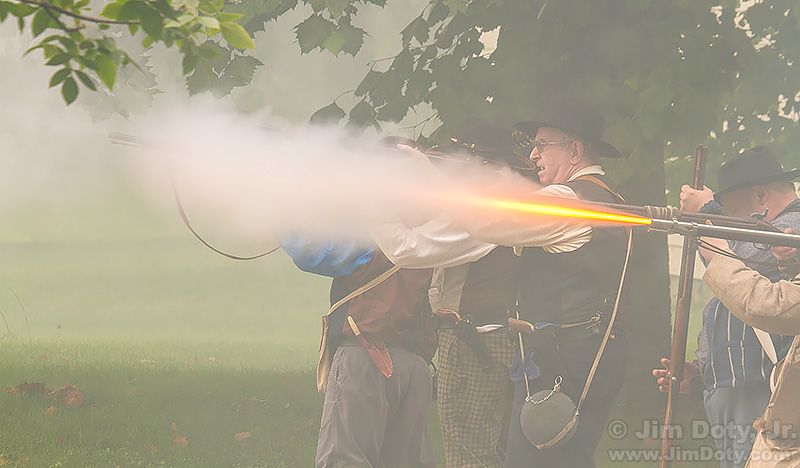A Civil War reenactment means catching some of the action. Catching a muzzle flash is ideal. How do you do this? You need the right kind of event, a good shooting location, and the proper technique.
Civil War Days is held each Labor Day weekend near Lamoni, a small town (population 2300) in Iowa. It is the largest event of its kind in southern Iowa and northern Missouri. They have several battles each year which are usually held in a location that allows for wide sweeping troop movements and cavalry charges. Unfortunately, this puts spectators (and photographers) a hundred or more yards away from the action. This year was different.
The Saturday morning battle was fought in town in an area that included several blocks of residential neighborhoods, downtown, and a city park. This allowed careful photographers to get very close to the action and still stay out of the line of fire. For safety reasons, you cannot be in front of the rifles or canons of either side
Civil War era muzzle loaders put out so much smoke that a group volley would totally obscure all the soldiers. I would have to wait for the smoke to clear a bit and for one individual to shoot to see any faces and capture the flames of a muzzle flash, or try to catch the very beginning of a volley. I had to watch the soldiers carefully and be quick on the trigger finger.
It is not a matter of holding the shutter open like a machine gun to get the shot. The Canon 7D can shoot continuously at 8 frames per second, but that doesn’t help as much as you might think. I was shooting at 1/160 second, which means in one second’s time the shutter is open only a total of 8/160 second (1/160 added eight times) and closed 152/160 second. In other words the shutter is open only 5% of the time (illustration below). With a virtually instantaneous moment like a muzzle flash, at 8 frames per second and 1/160 second shutter speed, the odds are 1 in 20 that you will get what you want.
Faster shutter speeds mean the shutter is open an even smaller percentage of time. If you are using a shutter speed of 1/500 second (which is not unusual for action photography), at 8 frames per second the shutter is only open a total of 8/500 second in one second’s time and closed 492/500 second. The shutter is open less than 2% of the time. You increase your odds by using the slowest shutter speed you can get away with and still freeze the action.
The key is to anticipate, just like any good sports photographer, and push the shutter just a hair before the anticipated moment and rip off 5-8 shots. It also helps if several people are firing their mule loaders at almost the same time. That will increase your odds.
I was watching several other photographers who were machine gunning the action. They would rip off a bunch of shoots, look at the images, get a frustrated look on their faces and try again. This happened over and over. They learned it is harder than it looks. No matter the burst rate of your camera, anticipation of the right moment is the key. And a bit of luck.
You could, of course, use a 1/10 second shutter speed. At a rate of 8 frames per seconds the shutter would be open 8/10 of a second in one second’s time and closed 2/10 second. Now your odds of catching the muzzle flash are 80% (assuming you picked the right second to shoot). The problem is all of the action of the battle would be blurred with a 1/10 second shutter speed. On the other hand, that might be a nice effect.
Photo Data: Canon 7D. Canon EF 70-300mm f/4.5-5.6 DO IS USM lens at 170 mm. 1/160 sec, f/8, ISO 800.
Links
When photographing a Civil War reenactment, be sure to capture some portraits.
Civil War Days, Lamoni, Iowa – the official site.


